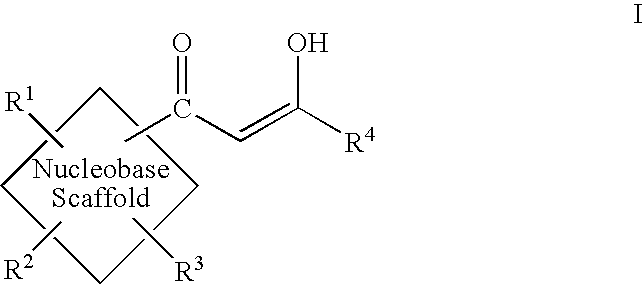Diketo acids on nucleobase scaffolds as inhibitors of Flaviviridae
a technology of nucleobase scaffolds and inhibitors, which is applied in the field of diketo acids on nucleobase scaffolds as inhibitors of flaviviridae, can solve the problem that the treatment effect is only effective for about 40% of patients
- Summary
- Abstract
- Description
- Claims
- Application Information
AI Technical Summary
Benefits of technology
Problems solved by technology
Method used
Image
Examples
example 1
REPRESENTATIVE EXAMPLE 1
Methyl-4-(1,3-dibenzyl-1,2,3,4-tetrahydro-2,4-dioxopyrimidin-5-yl)-2-hydroxy4-oxobut-2-enoate (3a)
[0327]
Step 1: preparation of 5-acetyl-1,3-dibenzyluracil (2a)
[0328]
[0329] A suspension of 5-acetyluracil (3.1 g, 20 mmol), and potassium carbonate (6.9 g, 50 mmol) in DMF (75 ml) was stirred for 20 min. Then benzyl bromide (6.0 ml, 50 mmol) was added. The resulting mixture was stirred for 8 h at room temperature. DMF was distilled under vacuum. The residue was purified by column (dichloromethane:methanol 40:1). The appropriate fraction was concentrated and crystallized from ethanol to afford 5.34 g of a white solid. Yield was 79.8%. Mp. 92-93° C. 1HNMR (CDCl3): 8.23 (s, 1H), 7.29-7.49 (m, 10H), 5.17 (s, 2H), 5.01 (s, 2H), 2.62 (s, 3H). 13CNMR (CDCl3): 194.5, 160.7, 151.0, 148.4, 136.2, 134.4, 129.2, 129.0, 128.9, 128.5, 128.2, 127.8, 112.2, 53.4, 44.9, 30.7. FAB-HRMS: [M+H]+ calcd. for C20H19N2O3 335.1396, found 335.1412.
Step 2: preparation of methyl 4-(1,3-di...
example 2
REPRESENTATIVE EXAMPLE 2
4-(1,3-Dibenzyl-1,2,3,4-tetrahydro-2,4-dioxopyrimidin-5-yl)-2-hydroxy-4-oxobut-2-enoic acid (4a)
[0332]
[0333] A solution of methyl 4-(1,3-dibenzyl-1,2,3,4-tetrahydro-2,4-dioxopyrimidin-5-yl)-2-hydroxy-4-oxobut-2-enoate (3a) (757 mg, 1.8 mmol) in dioxane (100 ml) was refluxed with 1N HCl (60 ml) for 4h. The solution was evaporated to dryness. The resulting solid was recrystalized from hexane and ethyl acetate (3:1) to give 617 mg a pale yellow solid. Yield was 84.2%. Mp. 186-188° C. 1HNMR (DMSO-d6): 8.89 (s, 1H), 7.57 (s, 1H), 7.24-7.36 (m, 10H), 5.16 (s, 2H), 5.02 (s, 2H). “13CNMR (DMSO-d6): 186.1, 169.0, 163.2, 159.9, 151.1, 150.2, 136.5, 135.8, 128.7, 128.4, 128.0, 127.8, 127.6, 127.3, 107.7, 100.9, 52.8, 44.2. FAB-HRMS: [M+H]+ calcd. for C22H19N2O6 407.1243, found 407.1248.
example 3
REPRESENTATIVE EXAMPLE 3
Methyl 4-[1,3-bis(2-fluorobenzyl)-1,2,3,4-tetrahydro-2,4-dioxopyrimidin-5-yl]-2-hydroxy-4-oxobut-2-enoate (3b)
[0334]
Step 1: preparation of 1,3-bis(2-fluorobenzyl)-5-acetyluracil (2b)
[0335]
[0336] The title compound for this step was synthesized using a similar procedure to that described in Example 1, step 1, except that benzyl bromide was replaced with 2-fluorobenzyl bromide. The yield was 43.9%. Mp. 149-150° C. 1HNMR (CDCl3): 8.35 (d, 1H, J=1.0 Hz), 7.36-7.44 (m, 2H), 7.04-7.26 (m, 6H), 5.24 (s, 2H), 5.07 (s, 2H), 2.62 (s, 3H). 13CNMR (CDCl3): 194.3, 161.1 (d, J=247.9 Hz), 160.7 (d, J=247.9 Hz), 160.6, 150.8, 148.8 (d, J=2.9 Hz), 131.3 (d, J=3.4 Hz), 130.9 (d, J=8.2 Hz), 129.19 (d, J=8.2 Hz), 129.17 (d, J=2.9 Hz), 124.7 (d, J=3.8 Hz), 124.1 (d, J=3.8 Hz), 123.1 (d, J=14.5 Hz), 121.4 (d, J=14.5 Hz), 115.9 (d, J=21.6 Hz), 115.5 (d, J=21.6 Hz), 112.2, 47.8, 38.8, 30.6.
[0337] FAB-HRMS: [M+H]+ calcd. for C20H17F2N2O3 371.1207, found 371.1202.
Step 2: preparati...
PUM
| Property | Measurement | Unit |
|---|---|---|
| temperature | aaaaa | aaaaa |
| crystal structure | aaaaa | aaaaa |
| concentration | aaaaa | aaaaa |
Abstract
Description
Claims
Application Information
 Login to View More
Login to View More - R&D
- Intellectual Property
- Life Sciences
- Materials
- Tech Scout
- Unparalleled Data Quality
- Higher Quality Content
- 60% Fewer Hallucinations
Browse by: Latest US Patents, China's latest patents, Technical Efficacy Thesaurus, Application Domain, Technology Topic, Popular Technical Reports.
© 2025 PatSnap. All rights reserved.Legal|Privacy policy|Modern Slavery Act Transparency Statement|Sitemap|About US| Contact US: help@patsnap.com



